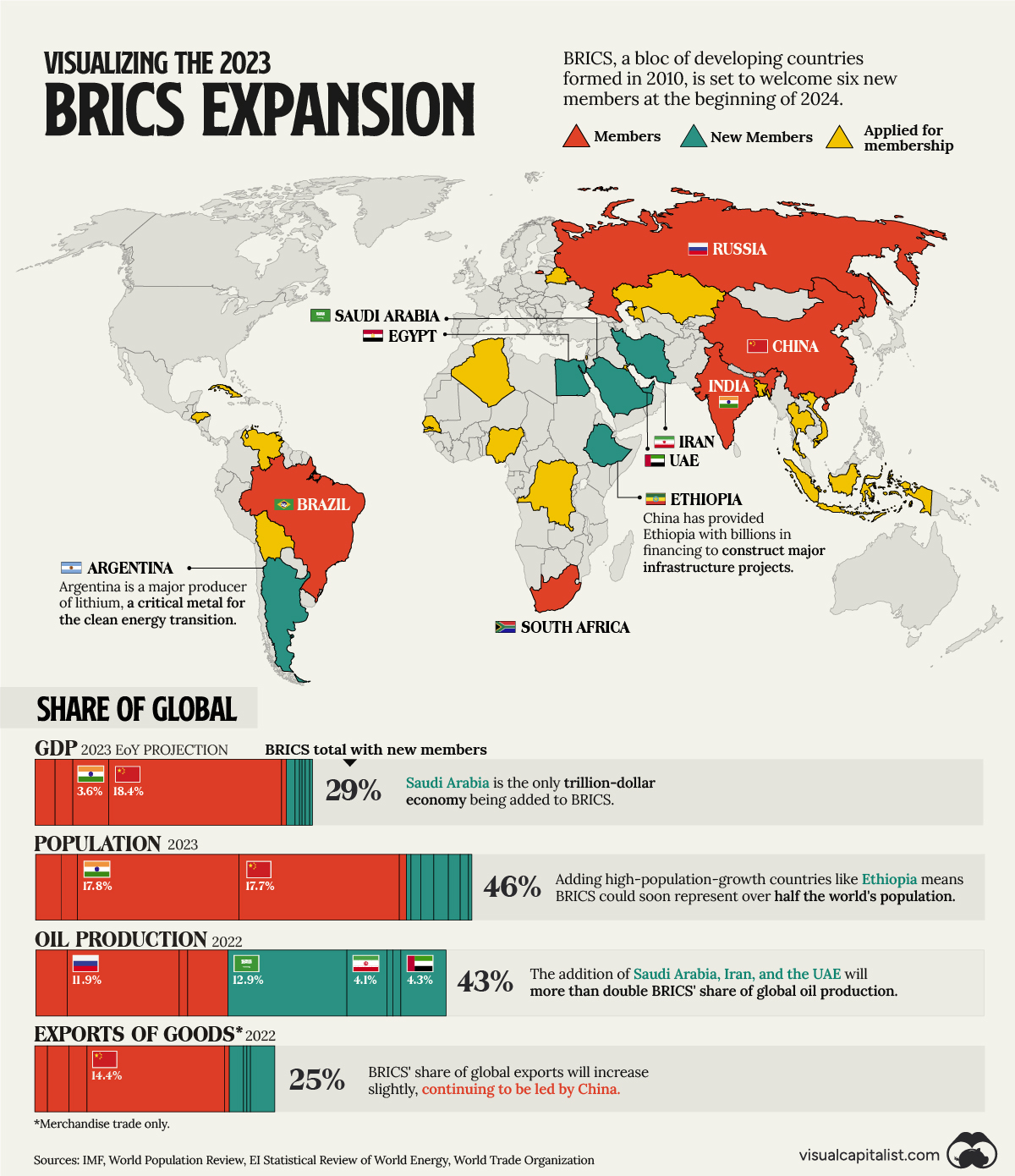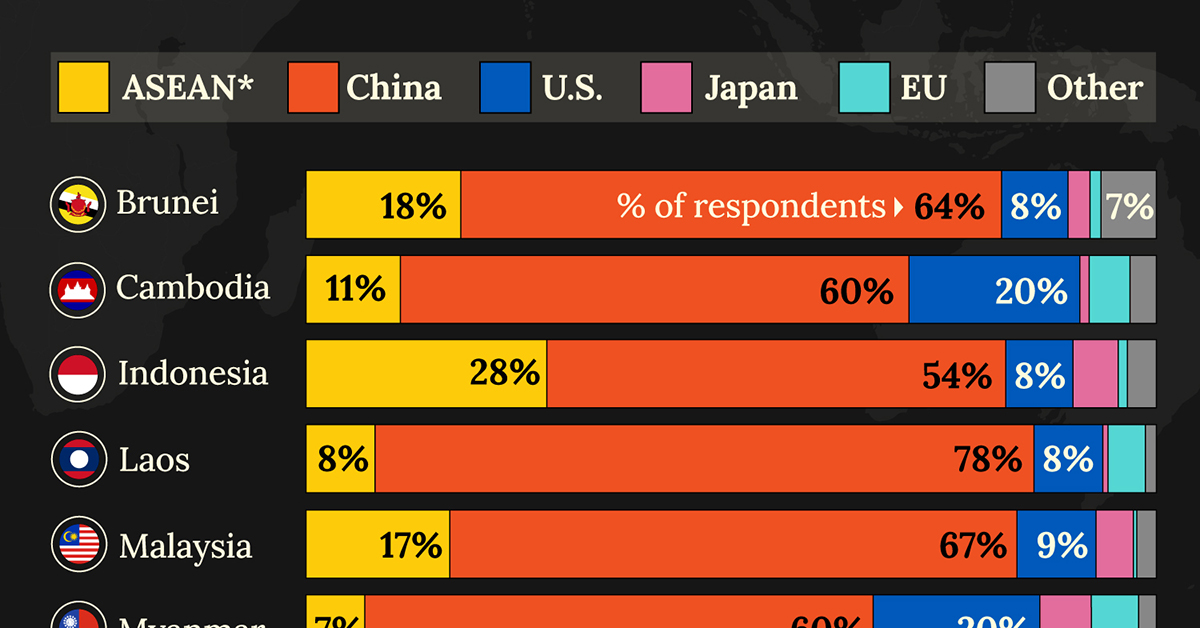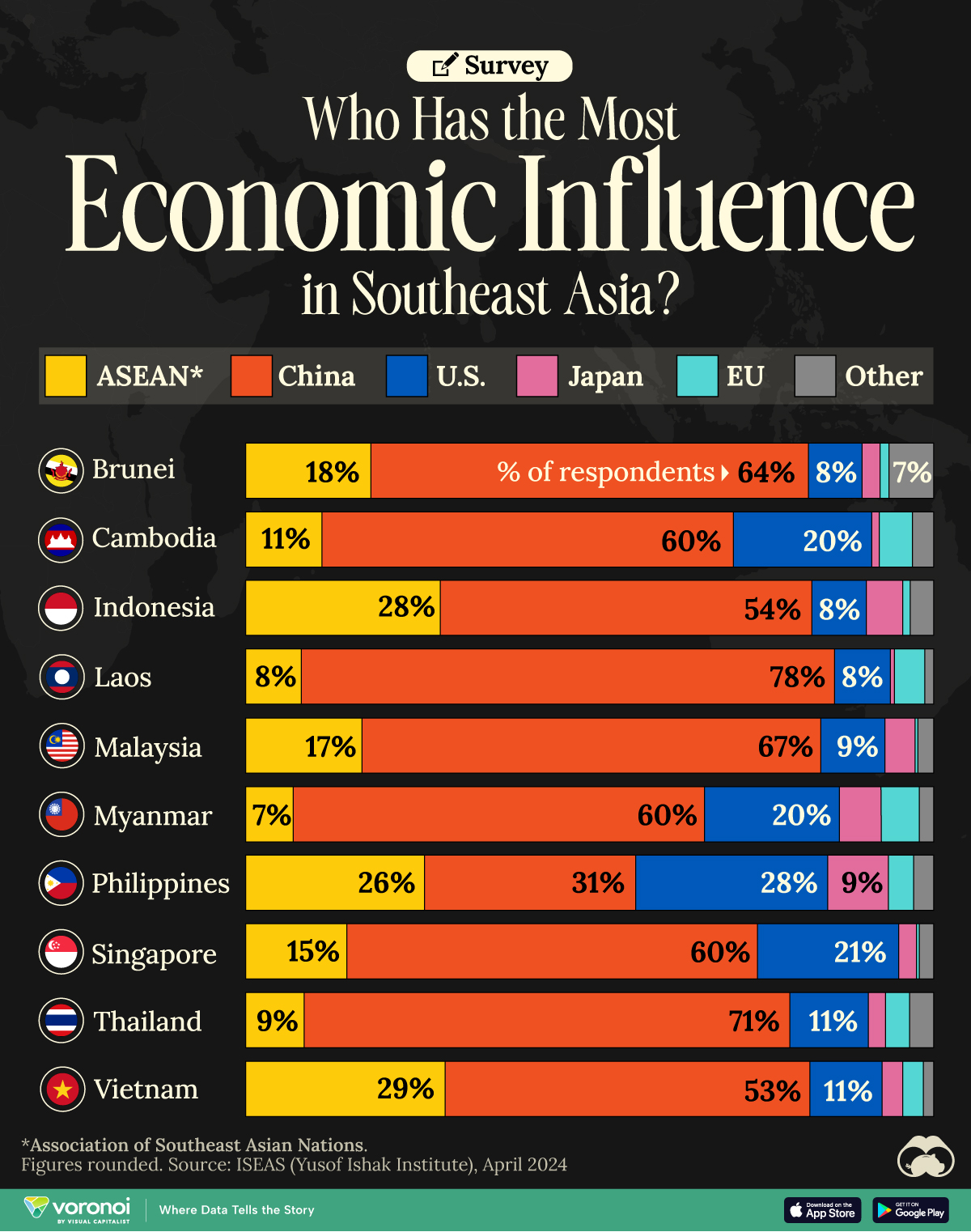Politics
Visualizing the BRICS Expansion in 4 Charts

Visualizing the BRICS Expansion in 4 Charts
BRICS is an association of five major countries including Brazil, Russia, India, China, and South Africa. Distinguished by their emerging economies, the group has sought to improve diplomatic coordination, reform global financial institutions, and ultimately serve as a counterbalance to Western hegemony.
On Aug. 24, 2023, BRICS announced that it would formally accept six new members at the start of 2024: Saudi Arabia, Iran, Ethiopia, Egypt, Argentina, and the United Arab Emirates (UAE).
In this graphic, we provide a data-driven overview of how the BRICS expansion will grow the group’s influence and reach.
Share of Global GDP
Because most of the new BRICS members are considered to be developing economies, their addition to the group will not have a major impact on its overall share of GDP.
The following table includes GDP projections for 2023, courtesy of the IMF.
| Original BRICS Member | Country | GDP (USD billions) | Share of Global (%) |
|---|---|---|---|
| Yes | 🇧🇷 Brazil | $2,081 | 2.0% |
| Yes | 🇷🇺 Russia | $2,063 | 2.0% |
| Yes | 🇮🇳 India | $3,737 | 3.6% |
| Yes | 🇨🇳 China | $19,374 | 18.4% |
| Yes | 🇿🇦 South Africa | $399 | 0.4% |
| No | 🇸🇦 Saudi Arabia | $1,062 | 1.0% |
| No | 🇮🇷 Iran | $368 | 0.4% |
| No | 🇪🇹 Ethiopia | $156 | 0.1% |
| No | 🇪🇬 Egypt | $387 | 0.4% |
| No | 🇦🇷 Argentina | $641 | 0.6% |
| No | 🇦🇪 UAE | $499 | 0.5% |
| - | BRICS Total | $30,767 | 29.3% |
| - | Rest of World | $74,362 | 70.7% |
The original six BRICS members are expected to have a combined GDP of $27.6 trillion in 2023, representing 26.3% of the global total. With the new members included, expected GDP climbs slightly to $30.8 trillion, enough for a 29.3% global share.
Share of Global Population
BRICS has always represented a major chunk of global population thanks to China and India, which are the only countries with over 1 billion people.
The two biggest populations being added to BRICS are Ethiopia (126.5 million) and Egypt (112.7 million). See the following table for population data from World Population Review, which is dated as of 2023.
| Original BRICS Member | Country | Population | Share of Global (%) |
|---|---|---|---|
| Yes | 🇧🇷 Brazil | 216,422,446 | 2.7% |
| Yes | 🇷🇺 Russia | 144,444,359 | 1.8% |
| Yes | 🇮🇳 India | 1,428,627,663 | 17.8% |
| Yes | 🇨🇳 China | 1,425,671,352 | 17.7% |
| Yes | 🇿🇦 South Africa | 60,414,495 | 0.8% |
| No | 🇸🇦 Saudi Arabia | 36,947,025 | 0.5% |
| No | 🇮🇷 Iran | 89,172,767 | 1.1% |
| No | 🇪🇹 Ethiopia | 126,527,060 | 1.6% |
| No | 🇪🇬 Egypt | 112,716,598 | 1.4% |
| No | 🇦🇷 Argentina | 45,773,884 | 0.6% |
| No | 🇦🇪 UAE | 9,516,871 | 0.1% |
| - | BRICS Total | 3.7 billion | 46.0% |
| - | Rest of World | 4.3 billion | 54.0% |
It’s possible that BRICS could eventually surpass 50% of global population, as many more countries have expressed their desire to join.
Share of Oil Production
Although the world is trying to move away from fossil fuels, the global oil market is still incredibly large—and BRICS is set to play a much bigger role in it. This is mostly due to the admission of Saudi Arabia, which alone accounts for 12.9% of global oil production.
Based on 2022 figures from the Energy Institute Statistical Review of World Energy, BRICS’ share of oil production will grow from 20.4% to 43.1%.
| Original BRICS Member | Country | Thousand Barrels per Day | Share of Global (%) |
|---|---|---|---|
| Yes | 🇧🇷 Brazil | 3,107 | 3.3% |
| Yes | 🇷🇺 Russia | 11,202 | 11.9% |
| Yes | 🇮🇳 India | 737 | 0.8% |
| Yes | 🇨🇳 China | 4,111 | 4.4% |
| Yes | 🇿🇦 South Africa | 0 | 0.0% |
| No | 🇸🇦 Saudi Arabia | 12,136 | 12.9% |
| No | 🇮🇷 Iran | 3,822 | 4.1% |
| No | 🇪🇹 Ethiopia | 0 | 0.0% |
| No | 🇪🇬 Egypt | 613 | 0.7% |
| No | 🇦🇷 Argentina | 706 | 0.8% |
| No | 🇦🇪 UAE | 4,020 | 4.3% |
| - | BRICS Total | 40,454 | 43.1% |
| - | Rest of World | 53,394 | 56.9% |
It’s worth noting that China has been pushing for oil trade to be denominated in yuan, and that Saudi Arabia’s acceptance into BRICS could bolster this ambition, potentially shifting the dynamics of global oil trade.
Share of Global Exports
The last metric included in our graphic is global exports, which is based on 2022 data from the World Trade Organization. We can see that the BRICS expansion will grow the group’s share of global exports (merchandise trade) to 25.1%, up from 20.2%.
| Original BRICS Member | Country | Exports (USD billions) | Share of Global (%) |
|---|---|---|---|
| Yes | 🇧🇷 Brazil | 334 | 1.3% |
| Yes | 🇷🇺 Russia | 532 | 2.1% |
| Yes | 🇮🇳 India | 453 | 1.8% |
| Yes | 🇨🇳 China | 3,594 | 14.4% |
| Yes | 🇿🇦 South Africa | 123 | 0.5% |
| No | 🇸🇦 Saudi Arabia | 410 | 1.6% |
| No | 🇮🇷 Iran | 73 | 0.3% |
| No | 🇪🇹 Ethiopia | 3.9 | 0.02% |
| No | 🇪🇬 Egypt | 49 | 0.2% |
| No | 🇦🇷 Argentina | 88 | 0.4% |
| No | 🇦🇪 UAE | 599 | 2.4% |
| - | BRICS Total | 6,259 | 25.1% |
| - | Rest of World | 18,646 | 74.9% |
Unsurprisingly, China is the world’s largest exporter. Major exporters that are not a part of BRICS include the U.S. (8.3%), Germany (6.6%), the Netherlands (3.9%), and Japan (3.0%).
Who Else Wants to Join?
According to Reuters, there are over 40 countries that have expressed interest in joining BRICS. A smaller group of 16 countries have actually applied for membership, though, and this list includes Algeria, Cuba, Indonesia, Palestine, and Vietnam.
As the group grows in size, differing opinions and priorities among its members could create tensions in the future. For example, India and China have had numerous border disputes in recent years, while Brazil’s newly elected President has sought to “kickstart a new era of relations” with the U.S.
One thing that is certain, however, is that a new acronym for the group will be needed very soon.
China
Which Countries Have the Most Economic Influence in Southeast Asia?
One country dominates this survey of who has the most economic influence in the region.

Countries With the Most Economic Influence in Southeast Asia
This was originally posted on our Voronoi app. Download the app for free on iOS or Android and discover incredible data-driven charts from a variety of trusted sources.
This chart visualizes the results of a 2024 survey conducted by the ASEAN Studies Centre at the ISEAS-Yusof Ishak Institute.
Nearly 2,000 respondents from 10 countries were asked to select which country/region they believe has the most influential economic power in Southeast Asia.
The countries surveyed are all member states of the Association of Southeast Asian Nations (ASEAN), a political and economic union of 10 countries in Southeast Asia.
Southeast Asia Perceptions: Who’s Got Economic Influence?
Across all ASEAN nations, China is regarded as the region’s most influential economic power.
Laos and Thailand had the highest share of respondents picking China, at 78% and 71% respectively. As the report points out, China is Laos’ largest foreign investor as well as its top export market.
| Country | 🇨🇳 China | 🌏 ASEAN | 🇺🇸 U.S. |
|---|---|---|---|
| 🇧🇳 Brunei | 64% | 18% | 8% |
| 🇰🇭 Cambodia | 60% | 11% | 20% |
| 🇮🇩 Indonesia | 54% | 28% | 8% |
| 🇱🇦 Laos | 78% | 8% | 8% |
| 🇲🇾 Malaysia | 67% | 17% | 9% |
| 🇲🇲 Myanmar | 60% | 7% | 20% |
| 🇵🇭 Philippines | 31% | 26% | 28% |
| 🇸🇬 Singapore | 60% | 15% | 21% |
| 🇹🇭 Thailand | 71% | 9% | 11% |
| 🇻🇳 Vietnam | 53% | 29% | 11% |
Note: Percentages are rounded.
Other ASEAN countries usually score highly as well, along with the United States.
It’s only in the Philippines, where China (31%), the U.S. (28%) and ASEAN (26%) were perceived as having a similar amount of influence.
ASEAN, Japan, and the EU
Filipinos also rated Japan’s economic influence the highest (9%) compared to those surveyed in other ASEAN countries. In 2023, the Southeast Asian bloc celebrated 50 years of friendship with Japan, marking it as one of their most important “dialogue partners.”
| Country | 🇯🇵 Japan | 🇪🇺 EU | 🌐 Other |
|---|---|---|---|
| 🇧🇳 Brunei | 3% | 1% | 7% |
| 🇰🇭 Cambodia | 1% | 5% | 3% |
| 🇮🇩 Indonesia | 5% | 1% | 3% |
| 🇱🇦 Laos | 1% | 4% | 1% |
| 🇲🇾 Malaysia | 4% | 0% | 2% |
| 🇲🇲 Myanmar | 6% | 6% | 2% |
| 🇵🇭 Philippines | 9% | 4% | 3% |
| 🇸🇬 Singapore | 3% | 0% | 2% |
| 🇹🇭 Thailand | 3% | 4% | 4% |
| 🇻🇳 Vietnam | 3% | 3% | 2% |
Note: Percentages are rounded. Other countries include: Australia, South Korea, India, and the UK.
The EU also received single-percentage responses, its highest share coming from Myanmar (6%), Cambodia (5%), and Laos (4%).
Finally, the report contrasted China’s robust economic influence with concerns about its growing impact in the region. Respondents from Vietnam (88%), Myanmar (88%), and Thailand (80%) had the highest levels of concern, despite their countries’ strong trade ties with China.
-

 Personal Finance1 week ago
Personal Finance1 week agoVisualizing the Tax Burden of Every U.S. State
-

 Misc6 days ago
Misc6 days agoVisualized: Aircraft Carriers by Country
-

 Culture7 days ago
Culture7 days agoHow Popular Snack Brand Logos Have Changed
-

 Mining1 week ago
Mining1 week agoVisualizing Copper Production by Country in 2023
-

 Misc1 week ago
Misc1 week agoCharted: How Americans Feel About Federal Government Agencies
-

 Healthcare1 week ago
Healthcare1 week agoWhich Countries Have the Highest Infant Mortality Rates?
-

 Demographics1 week ago
Demographics1 week agoMapped: U.S. Immigrants by Region
-

 Maps1 week ago
Maps1 week agoMapped: Southeast Asia’s GDP Per Capita, by Country

















